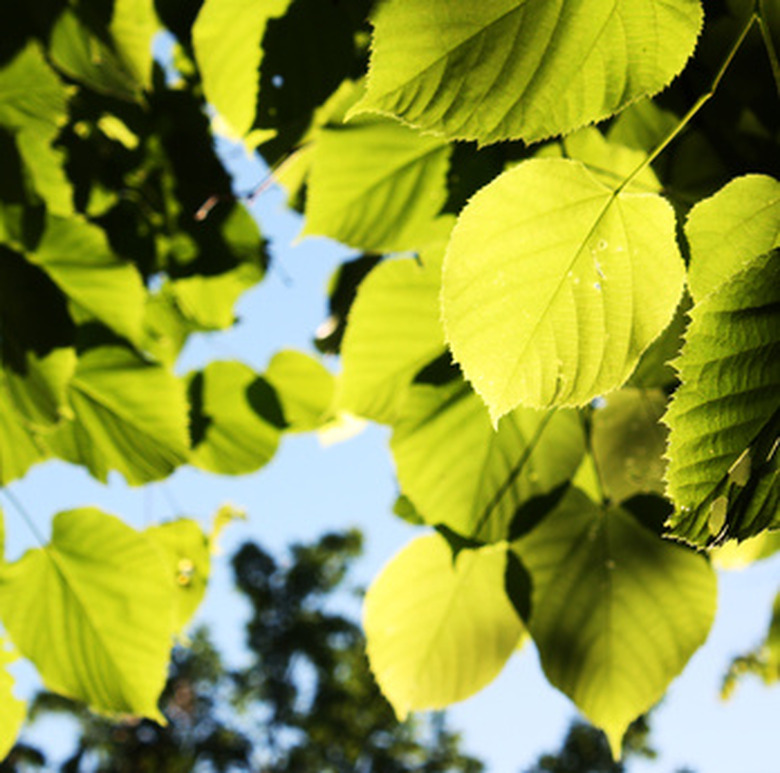Linden Tree Varieties
Famous in Europe and North America for being grand shade trees, lindens (Tilia spp.) also produce fragrant tiny greenish flowers that honeybees use to make a distinctively flavored honey. Deciduous, linden trees bear smooth bark and an oval to pyramid-like canopy with heart-shaped leaves. Choose a tree that is winter hardy in your region and tolerates your soil pH and moisture conditions.
American Linden
Usually called basswood, the American linden (Tilia Americana) grows large and imposing, not typically grown in residential gardens. It matures to 60 to 80 feet in height and 20 to 40 feet in width in deep, fertile and moist soils. 'Fastigiata' is a narrower oval, upright selection and 'Redmond' grows to 50 feet tall and 22 feet wide. Grow them in USDA Hardiness Zones 3 though 7.
- Famous in Europe and North America for being grand shade trees, lindens (Tilia spp.)
- Fastigiata' is a narrower oval, upright selection and 'Redmond' grows to 50 feet tall and 22 feet wide.
Littleleaf Linden
A well-shaped tree for use in yard, parks or lining avenues, littleleaf linden (Tilia cordata) has a reputation for tolerating tough urban conditions such as heavy clay, alkaline soils and moderate drought better than other lindens. Branches also take well to shearing to create tall hedgerows. The tree typically matures to 30 to 50 feet tall and 20 to 30 feet wide. A tight pyramidal canopy forms on 'Chancellor' and 'Greenspire' while a more oval, openly rounded canopy develops on varieties 'Glenleven' and ' Olympic'. Abundant amounts of bee-attracting flowers occur on 'June Bride', and 'Summer Sprite' grows slowly to just 20 feet tall and 10 feet wide. Quite cold hardy, grow littleleaf lindens in USDA Hardiness Zones 3 though 8.
Silver Linden
Also a large shade or park tree, the silver linden (Tilia tomentosa) grows large heart-shaped leaves with silvery undersides that become most attractive in a sweeping breeze. Its smooth trunk bark also displays a silvery to pale gray tone. This species tolerates summer heat better than others. Young leaves on 'Sterling' display an especially silvery cast and overall this variety's branches develop an attractive structure and silhouette. 'Princeton' develops a broad pyramid-like canopy as does 'Green Mountain', which is fast growing. Silver lindens grow best in USDA Hardiness Zones 6 through 9.
- A well-shaped tree for use in yard, parks or lining avenues, littleleaf linden (Tilia cordata) has a reputation for tolerating tough urban conditions such as heavy clay, alkaline soils and moderate drought better than other lindens.
- Also a large shade or park tree, the silver linden (Tilia tomentosa) grows large heart-shaped leaves with silvery undersides that become most attractive in a sweeping breeze.
Bigleaf Linden
With the misleading name of "bigleaf", this species' leaves really are no larger than any other species but the stems are covered in long hairs, unlike any other linden. Bigleaf linden (Tilia platyphyllos) lines the formal boulevards and grand allees across much of Europe. Both 'Princess Street' and 'Rubra' are selections with vibrant, red-tinted young twigs. Grow this species in USDA Hardiness Zones 5 through 8.
Hybrid Lindens
Two man-made hybrids of note include the European linden (Tilia x europea or Tilia x vulgaris) and the Crimean linden (Tilia x euchlora). These two species grow well in USDA Hardiness Zones 3 or 4 through 7. The weeping silver linden (Tilia 'Petiolaris') is regarded by most botanists as a hybrid with a large size and weeping branches and drooping twigs. It grows 100 feet tall and 70 feet wide and best in USDA Zones 5 through 9.
- With the misleading name of "bigleaf", this species' leaves really are no larger than any other species but the stems are covered in long hairs, unlike any other linden.
- The weeping silver linden (Tilia 'Petiolaris') is regarded by most botanists as a hybrid with a large size and weeping branches and drooping twigs.
References
- "Dirr's Hardy Trees and Shrubs;" Michael A. Dirr; 1997
- "Journal of Arboriculture;" Checklists of Cultivars of Linden (Tilia) Species; Frank S. Santamour, Jr. and Alice Jacot McArdle; May 1985
- "A-Z Encyclopedia of Garden Shrubs;" Editors Christopher Brickell and H. Marc Cathey
- National Gardening Association: USDA Hardiness Zone Finder
